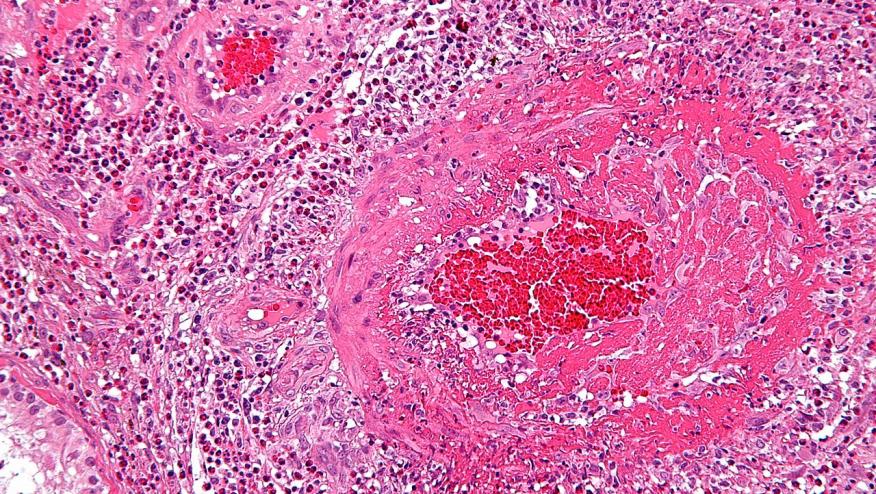Shorter Steroid Courses Effective in ANCA+ Vasculitis Save

An 8-week course of prednisone plus rituximab (Rituxin) offered good outcomes in patients with antineutrophil cytoplasmic antibody (ANCA)-associated vasculitis (AAV), including complete remission, researchers reported.
The pilot study in 20 adult patients yielded a 70% complete remission rate at 6 months. This remission rate was virtually identical to that observed in 29 historical controls taken from the Rituximab in AAV (RAVE) trial, which involved 5.5 months of steroid therapy, according to Eli M. Miloslavsky, MD, of Massachusetts General Hospital in Boston.
"Our pilot trial demonstrates that regimens utilizing shorter courses of glucocorticoids deserve further study with a particular focus on select patient populations that may derive the greatest benefit from such an approach," they wrote in Seminars in Arthritis and Rheumatism.
The study is part of the ongoing effort to reduce the morbidity and mortality related to glucocorticoid treatment. AAV patients still have almost three times the risk of death as the general population, although survival has dramatically increased since the 1960s when glucocorticoid and cyclophosphamide treatments were introduced.
The study enrolled patients at a tertiary-care center with active AAV. Of these, 65% were women, 70% had granulomatosis, and 55% were newly diagnosed. The median Birmingham Vasculitis Activity Score for Wegener's Granulomatosis (BVAS/WG) at entry was 5 (range 3-11). Five patients had renal involvement and one had pulmonary hemorrhage. Patients with severe glomerulonephritis or diffuse alveolar hemorrhage requiring mechanical ventilation were ineligible.
Participants underwent a rapid 8-week prednisone taper in combination with rituximab at a dose of 375mg/m2 weekly for the first 4 weeks. Prednisone tapering was 60 mg for 2 weeks, 40 mg for 2 weeks, 30 mg for 1 week, 20 mg for 1 week, 10 mg for 1 week, and 5 mg for 1 week.
The primary endpoint was complete remission at 24 weeks, defined as no disease activity (BVAS/WG=0), completion of prednisone taper, and no intervening relapses.
Fourteen of 20 patients achieved the primary outcome, a rate comparable to the 69% of the conventionally treated control group from RAVE, for an adjusted odds ratio of 1.31 (95% CI 0.26-6.56). Despite having fewer median adverse events per patient (2 versus 8, P<0.001) study participants were more likely to relapse (30% versus 7%, P=0.03), with most relapses affecting those who had severe vasculitic manifestations at baseline.
There were no grade 3 infection and few serious adverse events, and disease-related damage was similar in both trial populations, according to the authors.
"This study poses the provocative question of whether we can challenge a subset of patients with AAV to perhaps get away with more rapid steroid tapering, particularly if we give them a potent remission induction medication such as rituximab, as was done in this study," said Robert F. Spiera, MD,of Weill Cornell Medical College in New York City, to MedPage Today.
This approach might apply especially to those with less severe disease, and those more sensitive to steroid side effects such as the elderly, those with poorly controlled diabetes, and those developing neuropsychological issues on treatment, added Spiera who was not involved in the study.
He noted that some rheumatologists, himself included, are intuitively taking this steroid-tapering approach in practice, re-treating as necessary in the case of flares and carefully watching for damage.
"You don't want patients to accrue kidney, nerve or lung damage, but you also don't want to expose patients to more steroids, which ... can result in damage from steroid side effects just to avoid a flare," Spiera said. He stressed that patients must be closely monitored.
"This pilot study at least invites people to think about doing more formal trials comparing more rapid and less rapid tapering of steroids," he added.
Study limitations included the small patient sample, historical-control design, lack of power, and short follow-up. "A larger study with a longer follow-up period is required to understand more fully the long-term outcomes of patients who receive a shortened glucocorticoid course, particularly with regard to frequency of flares, accrual of disease damage and total amount of glucocorticoids utilized," the authors noted.








If you are a health practitioner, you may Login/Register to comment.
Due to the nature of these comment forums, only health practitioners are allowed to comment at this time.